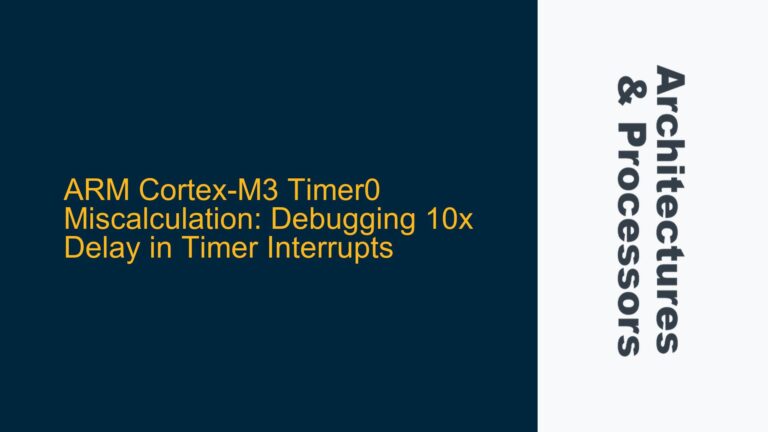ARM Cortex-M0+ NOP Cycle Time and Interrupt Latency Anomalies
The ARM Cortex-M0+ is a highly efficient and widely used microcontroller core, known for its simplicity and low power consumption. However, when operating at a clock frequency of 40MHz, the expected cycle time for a NOP instruction should be 25ns. Instead, measurements indicate a cycle time of approximately 125ns, which is five times longer than expected. Additionally, the interrupt latency is significantly higher than the datasheet specifications, with NMI latency at 3ms and GPIO interrupt latency ranging from 4-6us, compared to the expected 500ns. These discrepancies suggest underlying issues in the system configuration or execution environment that need to be thoroughly investigated.
The NOP instruction, which should ideally take one clock cycle to execute, is exhibiting a cycle time that implies an effective clock speed of 8MHz rather than the configured 40MHz. This discrepancy is further compounded by the interrupt latency issues, which are critical for real-time applications. The combination of these symptoms points to potential misconfigurations in the clock system, memory access timing, or interrupt handling mechanisms.
Clock Configuration and Memory Access Timing Issues
The primary suspect in this scenario is the clock configuration. The Cortex-M0+ core relies on an accurate and stable clock source to execute instructions at the expected speed. The external oscillator is configured to provide a 40MHz clock, and the prescaler values have been verified to ensure that the core is indeed running at this frequency. However, the observed NOP cycle time suggests that the core might not be receiving the full 40MHz clock signal.
One possible cause is the presence of additional clock dividers or multipliers that are not accounted for in the prescaler verification. The clock tree in modern microcontrollers can be complex, with multiple stages of division and multiplication before the clock signal reaches the core. If any of these stages are misconfigured, the effective clock frequency seen by the core could be significantly lower than expected.
Another potential issue is memory access timing. The Cortex-M0+ core has zero wait states for memory access, as stated in the datasheet. However, if the memory subsystem is not properly configured or if there are delays in accessing the flash memory or SRAM, this could introduce additional latency in instruction execution. The NOP instruction, while simple, still requires fetching from memory, and any delay in this process would manifest as an increased cycle time.
Interrupt latency is also heavily influenced by the memory subsystem. If the core is experiencing delays in fetching the interrupt vector or executing the interrupt service routine (ISR), this would result in higher latency. The Cortex-M0+ core has a relatively simple interrupt handling mechanism, but any inefficiencies in the memory access path can have a significant impact on performance.
Verifying Clock Configuration and Optimizing Interrupt Handling
To address the NOP cycle time discrepancy, the first step is to verify the clock configuration in detail. This involves checking all stages of the clock tree, including any PLLs, dividers, and multipliers, to ensure that the core is receiving the correct clock frequency. Tools such as oscilloscopes or logic analyzers can be used to measure the actual clock signal at various points in the clock tree. Additionally, the microcontroller’s clock control registers should be reviewed to confirm that all settings are correct.
Once the clock configuration is confirmed, the next step is to investigate the memory access timing. This involves reviewing the memory controller settings and ensuring that the flash memory and SRAM are configured for zero wait states. If the memory subsystem is introducing delays, it may be necessary to adjust the timing parameters or optimize the memory access sequence.
For the interrupt latency issue, the focus should be on optimizing the interrupt handling mechanism. This includes ensuring that the interrupt vectors are stored in fast-access memory and that the ISR is as efficient as possible. The Cortex-M0+ core has a feature called "vector table offset" that allows the interrupt vector table to be relocated to SRAM, which can reduce access time. Additionally, the priority of the interrupts should be reviewed to ensure that higher-priority interrupts are serviced first.
In cases where the interrupt latency is still higher than expected, it may be necessary to use hardware-based solutions such as DMA (Direct Memory Access) to offload data transfer tasks from the CPU. This can reduce the load on the core and improve overall system responsiveness.
Finally, it is important to consider the impact of the development environment and tools. Compiler optimizations, linker scripts, and debug settings can all influence the performance of the code. Ensuring that the code is compiled with the appropriate optimization level and that the linker script is configured to place critical sections of code and data in fast-access memory can help to mitigate some of the observed issues.
In conclusion, the observed discrepancies in NOP cycle time and interrupt latency on the ARM Cortex-M0+ are likely due to misconfigurations in the clock system, memory access timing, or interrupt handling mechanisms. By carefully verifying the clock configuration, optimizing memory access, and improving interrupt handling, it is possible to achieve the expected performance levels. Additionally, attention to the development environment and tools can further enhance system performance.






